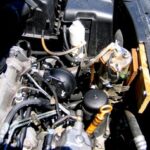It is becoming more and more common for people to use automobile engines in there homebuilt aircraft. This is primarily because of the cost of aero engines, in addition to their antiquated technology. There are however, a number of factors that need to be considered if you are planning to use an auto conversion in your homebuilt aircraft.
The biggest reason that most people have for using an automobile engine in their homebuilt aircraft is cost. The auto manufacturers produce millions of engines every year and this gives them a huge economy of scale advantage over aircraft engine manufacturers who produce only a few thousand engines each year. Aircraft engines also have to go through an extensive certification process which greatly adds to the cost. The result of all this is that an auto engine costs a small fraction of what an aircraft engine costs.
Another factor that makes auto engines appealing to many homebuilders is that they are also cheaper to operate. Automobile engines are much more fuel efficient than aircraft engines, primarily because they are a much more sophisticated design. Most light aircraft engines have been using the same design for the last sixty years, primarily because of the cost of getting a new design certified. Automobile engines on the other hand are constantly being updated and redesigned and as a result are much more sophisticated than airplane engines, when was the last time you saw a magneto on a car.
Although there are a lot of advantages to auto engine conversions there are a few disadvantages that have to be considered, the biggest one being that automobile engines weren’t designed for use in airplanes. This is primarily a problem because auto engines run faster than airplane engines. Cars are designed so that the engine provides maximum torque at somewhere between 5000-6000 RPM, but airplanes need to have maximum torque at about 2300 RPM. This means that for most auto conversions it is necessary to build a reduction gear, adding both weight and complexity to your aircrafts engine.
Weight is another issue with auto conversions. Weight is always a huge factor for aircraft so aero engines are designed to be as light as possible. This is less of an issue for cars so their engines do tend to weigh more than an aero engine of equal horsepower. In addition to the weight of the engine there is also the weight of the cooling system. Almost all car engines are liquid cooled, most aircraft engines are air cooled, if you are going to use an auto engine in your homebuilt you will need to add the weight of a liquid cooling system.
Another problem with auto engines is that they aren’t tested to run at full power for anywhere near the kind of time that aircraft engines are. Aircraft engines frequently operate at full power, and normally cruise at 75% power, cars rarely operate at anywhere near these kinds of power settings. When you use an aircraft engine you know that it has been tested for those power settings and are told how long it can operate at that power before it needs to be overhauled. You don’t know this with car engines, not to say they aren’t safe at these kinds of power settings, just remember that you don’t know how long a car engine can run at full power.
There are a lot of good reasons to consider using an auto conversion in your homebuilt aircraft but there are also a number of things that you need to think about. Engines, like everything else in aviation, are a trade off, no engine will meet all of your needs. You need to decide what’s important to you and make your decision based on that.




